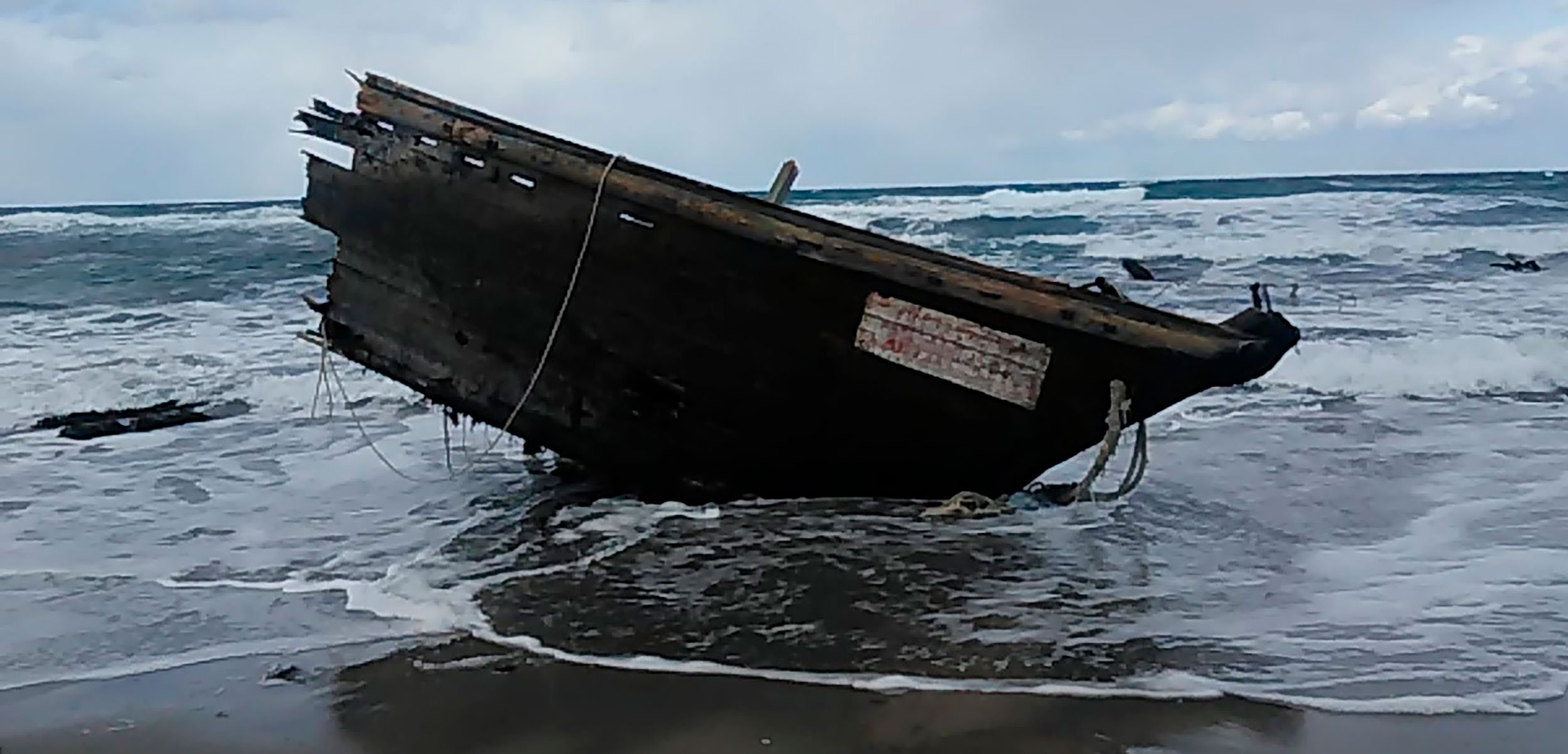How North Korea Built a Fleet of Ghost Ships
North Korean policies are driving fishermen—desperate, hungry, and ill-equipped—into dangerous, distant waters.
Article body copy
Another boat washed up in December. This one, discovered by police on Sado Island, Japan, was broken in two. Inside, police soon discovered its terrible cargo: five people—corpses—and a pair of human heads. There was little to identify the partially skeletonized victims. For a couple of days, this dreadful mystery, and the quiet island of cedar trees and endangered birds that hosted it, became the talk of the world.
What the police found on Sado, an island 30 kilometers west of mainland Japan, was alarming. More horrifying, though, is that this gruesome wreck was not unique. In 2018 alone, more than 200 vessels were found adrift or on beaches across Japan’s expansive western flank.
These are the ghost ships.
They are the result of desperate fishermen venturing far from shore without support or supplies.
Some of the ghost ships are found like the one on Sado—empty save for their dead and decomposing crews. Others are found eerily deserted in the sand, their crews lost to the depths before they reach Japanese shores. Whatever their fate, the crews of these ghost ships have something in common. As the splattered script on the side of the Sado Island wreck shows, these boats came from across the sea to the west—from North Korea.
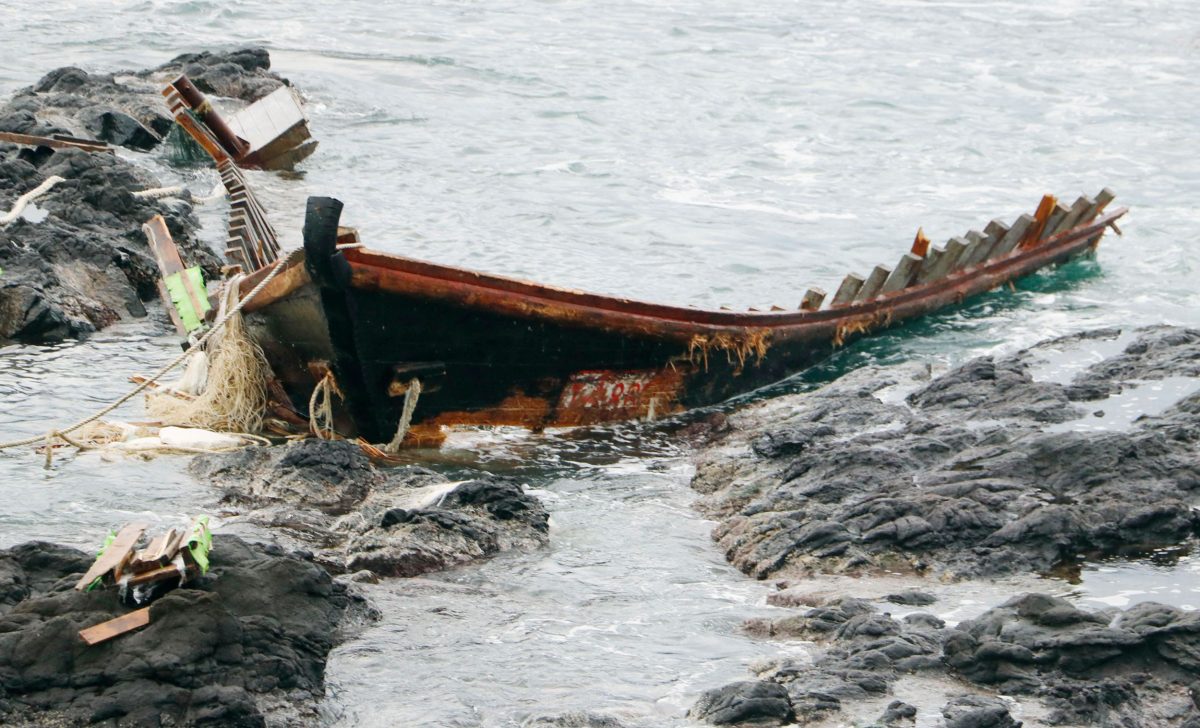
Currents sweep North Korean ghost ships east across the Sea of Japan. Photo by Kyodo News via AP Images
Excluded from their own fishing grounds and starved by foreign sanctions, North Korean fishermen have started venturing ever farther into the Korean East Sea, also known as the Sea of Japan. They do this even in bad weather, and even in vessels sometimes shorter than city buses. The result is hundreds of ghost ships, dozens of corpses, and many more missing bodies. These ghost ships are, however, only the most visible sign of a much larger problem.
To really understand the deaths of the men who washed up on Sado, you first have to understand the decades of failure that pushed them there, and the contemporary pressures on North Koreans to net fish—even if they risk dying along the way.
For centuries, long before the United States and the Soviet Union sliced the Korean Peninsula in two at the end of the Second World War, Koreans were suspicious of the sea.
In legends and stories, the open ocean was a chaotic place filled with monsters and capricious spirits—among them Yongwang, the so-called Dragon King who lives in a fabled underwater palace. Fishermen festooned their boats with shamanistic signs and charms to appease Yongwang and other spiritual beings, and were careful to avoid certain inauspicious rocks or inlets. Some of these practices survived into the early 20th century. Writing in 1933, one American missionary reported that skippers near the northern town of Haeju still visited their local mudang (shaman) before setting out to sea.
A few decades later, the newly minted Democratic People’s Republic of Korea (DPRK) under Kim Il-sung was keen to develop its fishing capabilities, and smashing those old myths was a great place to start. The regime, says Robert Winstanley-Chesters, an expert on North Korean fishing at the University of Leeds in England, was intent on “developing beyond any sort of superstition.” Yet as late as 1960, Winstanley-Chesters wrote in his book Fish, Fishing and Community in North Korea and Neighbours, North Korean officials grumbled about the need to eradicate mysticism in their seafaring comrades.
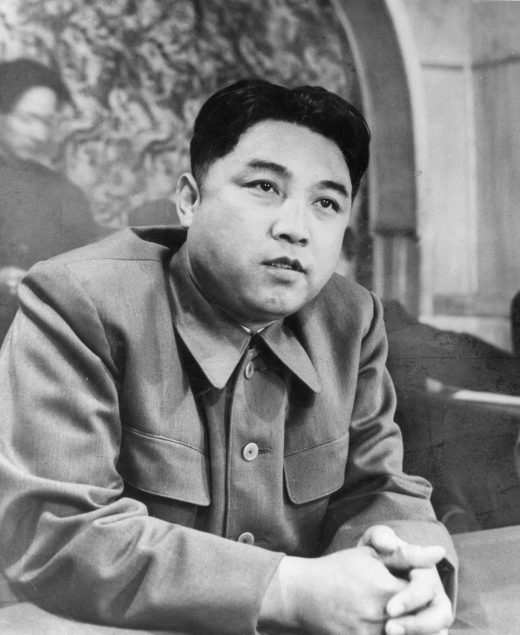
Kim Il-sung, leader of the Democratic People’s Republic of Korea from 1948 to 1994, pushed the country to develop its fishing capacity. Photo by RBM Vintage Images/Alamy Stock Photo
Even so, North Korea’s drive went way beyond educating the masses in rational materialism. Building a robust fishing fleet was a way to showcase the DPRK as a modern, successful socialist state, Winstanley-Chesters explains. Kim Il-sung, who led the DPRK from its inception in 1948 until his death in 1994, expressed that idea himself. Writing in 1948, for instance, Kim proclaimed that his government helped “set up a new fishing system” by nationalizing “fishing grounds, fishing boats, processing factories, netting plants and other fishing equipment and facilities formerly owned by Japanese imperialists, their collaborators and traitors to the nation.”
By the 1960s, North Korean fishermen were being corralled into one of the country’s ambitious “Six Goals” of industrial development—partly focused on fisheries, but encompassing everything from steel production to fabric manufacturing. Indeed, Kim’s desire to develop North Korea’s fishing capacity still reverberates today:
“Let this socialist country resound with Song of Big Fish Haul and be permeated with the fragrant smell of fish and other seafoods!” declared one recent government slogan.
And, as crooned by North Korean pop singers in leather jackets and military caps: “A big catch is taken in, the sound of full boats whistle in the harbor!”
By 1957, it was hoped that catches would soon reach up to 600,000 tonnes a year. Despite Soviet help, North Korea’s fishing successes never matched Kim Il-sung’s heady ideal. Bureaucratic incompetence, shambolic infrastructure, and woeful scientific research meant that, even by the 1970s, North Korean officials hardly knew what sorts of fish lived in the Korean East Sea. Not that they could have caught much anyway. By the end of the decade, North Korean trawlers rarely weighed more than 1,000 tonnes, while their South Korean neighbors were busy launching ships 10 times bigger.
The abrupt end of Soviet support in 1991 sparked a famine in the DPRK that killed as many as 3.5 million people, a humanitarian crisis that swiftly transformed North Korea’s state-building fishing efforts into a matter of survival. “After the economic collapse, fish became critical,” says Joseph Bermudez, a senior fellow at the Center for Strategic and International Studies in Washington, DC. “Fishing is now a significant part of the economy, especially because it provides protein for the mass of people in North Korea.”
Yet in recent years, North Korea sold the rights to its own coastal fishing grounds to China—probably to raise funds after being hit with foreign sanctions for nuclear testing. Though the deal may have scooped the regime around US $75-million in hard currency each year, it deprived North Korean fishermen of access to their traditional waters. That, in turn, has forced North Korean haulers farther out to sea in search of food—both for themselves, and for a regime that imposes tough quotas on fishing communities.
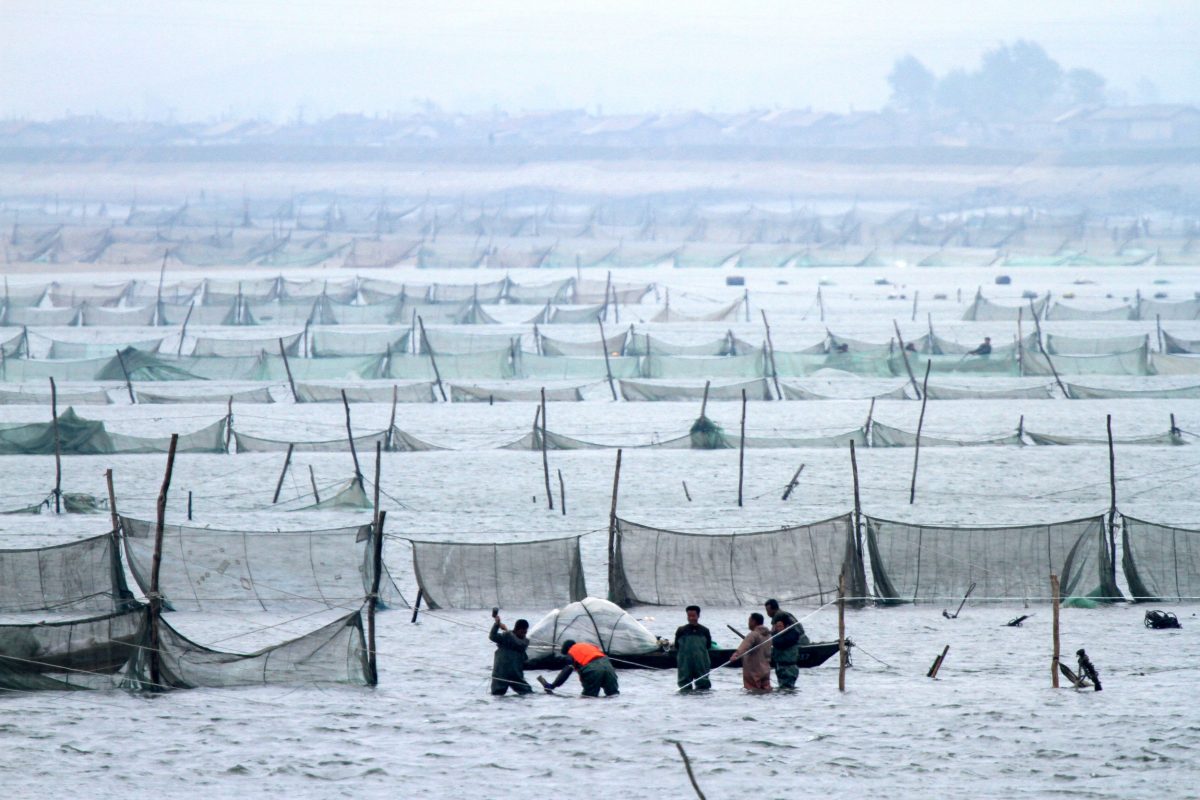
With foreign sanctions ravaging the North Korean economy, seafood has become a valuable source of income for fishermen, especially when it’s sold to Chinese markets. According to Chinese customs data, North Korea exported fish worth over US $156-million to its northern neighbor from January to October 2016, a 74 percent increase over the year before. Photo by FeatureChina/Newscom
In 2017, members of the United Nations, including Canada, implemented new sanctions to prevent North Korea from selling its fishing rights. But with 800 Chinese fishing vessels reported in North Korean waters last year, there is little evidence that either Beijing or Pyongyang is paying much attention to the UN’s efforts. The Chinese government claims that it “has consistently and conscientiously enforced the resolutions of the [UN] Security Council” relating to the DPRK. But when stopped by the South Korean coast guard on their way to North Korean waters, Chinese captains reportedly present fishing permits signed by North Korean officials.
For North Korean fishermen, desperation and coercion dovetail with another drive: cash. Nicholas Ahlmark, who in 2019 produced a documentary about North Korean ghost ships, says that, increasingly, North Korean skippers are independent operators—they get their fishing permits from the state, but are otherwise working for themselves. For those few who excel, offshore fishing can be lucrative work.
The North Korean regime doesn’t seem to care where this new breed of independent fishermen casts its nets. The government has apparently done nothing to stop them from trying their luck fishing illegally in foreign waters—a policy (or lack thereof) that leads some North Koreans to disaster.
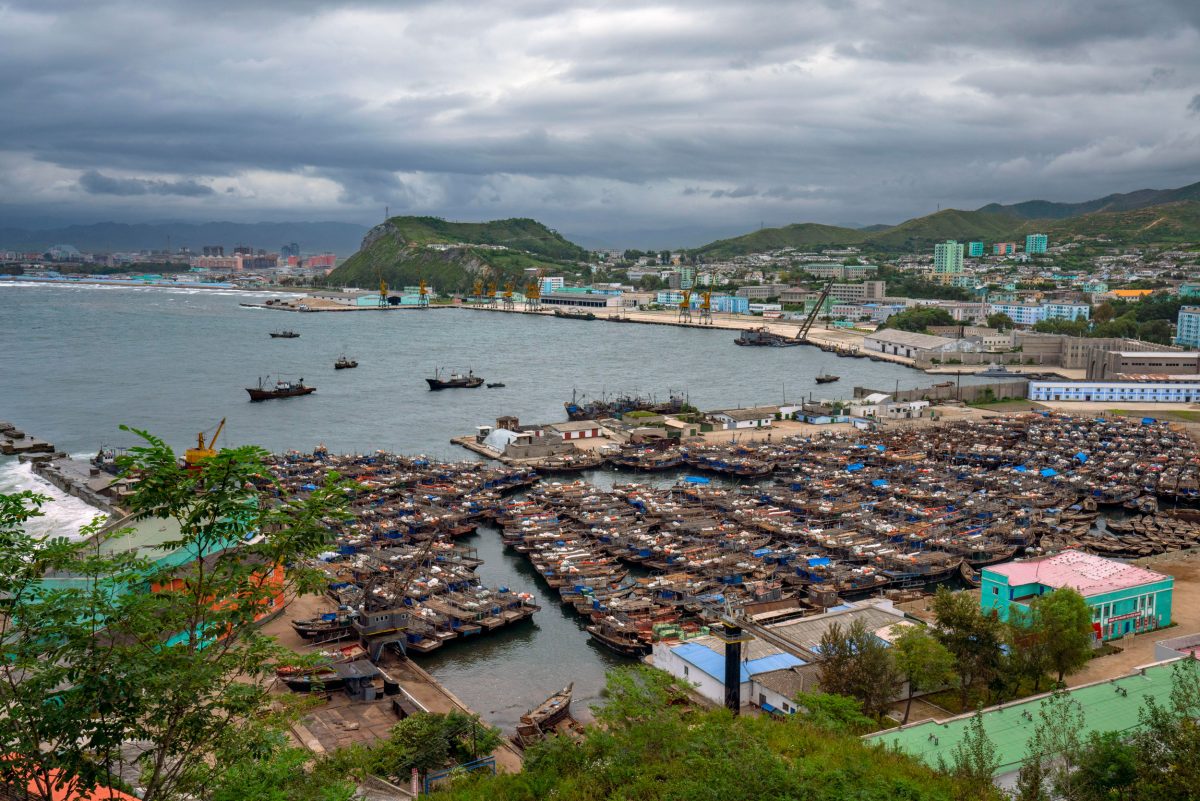
Even before the incident on Sado Island, Japan, the North Korean port city of Chongjin was known as Widows Town for the number of sailors who never come home. Photo by Hemis/Alamy Stock Photo
One hotspot for this poaching is the Yamato Bank. A vast area of shallow water, it is one of the richest fishing spots in the Korean East Sea. The bank is controlled by Japan as part of its exclusive economic zone (EEZ), but since around 2017 it has become a flashpoint for conflict between Japanese and North Korean boats. Japanese fishermen and the Japanese coast guard have often released videos showing North Korean boats in the EEZ—occasionally, boats collide and even sink. The situation became so bad over recent years, says Masayuki Komatsu, a retired official at the Fisheries Agency of Japan (FAJ), that “to avoid unnecessary clashes and competition,” Japanese fishermen “are starting to evacuate the area.”
And it is in this video footage that we may find an answer to the mystery of the ghost ships.
First, consider where these videos are filmed. Situated between North Korea and Japan, the Yamato Bank is some 500 kilometers from the North Korean port city of Chongjin. Though an easy journey for a modern trawler, North Koreans’ boats are rickety and wooden. Their puttering 36-horsepower engines and tattered tarpaulin shelters are barely adequate for placid coastal waters—let alone the rain and surf of the Yamato Bank, says Winstanley-Chesters. Add a lack of GPS equipment and it becomes easy to see how the invaders of the Yamato Bank could become the ghost ships of Japan. Once off course—or unable to beat strong currents—the sailors die of hunger or exposure, their vessels washing up in Japan weeks or months later. No wonder Chongjin recently gained a new nickname: Widows Town.
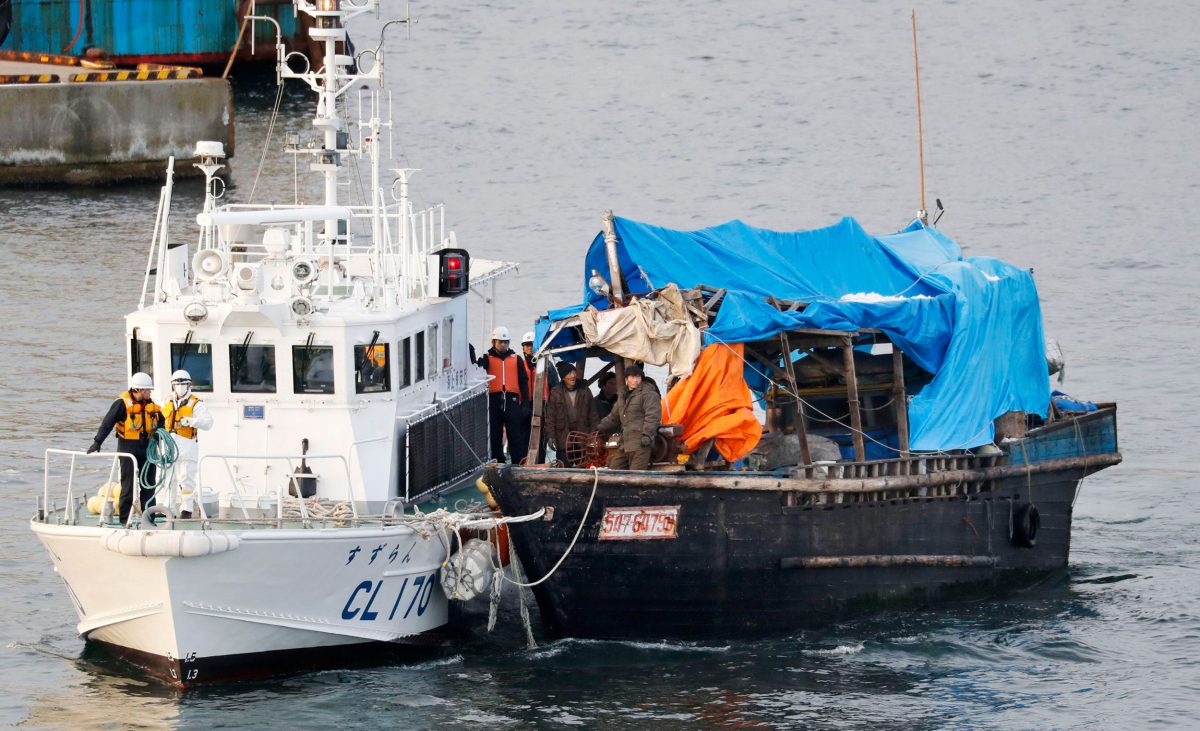
Many North Korean fishing vessels are ill-equipped to handle the rigors of fishing far from shore. Photo by Kyodo News via Newscom
But what about the boats that reach land empty, the only sign of their origins some faded lettering? Here the story may get even darker. According to one North Korean defector, some fishermen prefer suicide to starvation. And though the disembodied heads at Sado remain a mystery, defectors and foreign aid workers say North Koreans have sometimes resorted to cannibalism to avoid starvation.
However you explain the ghost ships, Winstanley-Chesters is in no doubt about what they represent: they are a stark symbol of the DPRK’s maritime failures. More to the point, they suggest that contemporary North Korea “is desperate for food resources, and desperate enough to put coastal communities at real risk, [and] break all the rules to poach fishing stocks.”
Nor is there much optimism for the future. “If Chinese boats are operating in North Korean coastal waters, then that will continue to push North Korean ships further out,” says James Brown, a political scientist at Temple University, Japan Campus.
Komatsu, for his part, refutes this assumption—at least for the moment. He says that with North Korea terrified about the spread of COVID-19, its boats are sticking closer to shore, in turn displacing Chinese ships to Japanese waters. He has a point: the number of North Korean vessels reported in the Yamato Bank has recently plummeted, with hundreds of Chinese boats replacing them.
All the same, many other experts believe this is likely just a temporary situation—when the pandemic eases, they argue, North Korean fishermen will go right back to putting themselves in deadly danger far from home. And certainly, with the Yellow Sea between China and North Korea ecologically ruined—in 1998, the average catch in its waters was only 4.3 percent of what it was in 1982—China seems unlikely to permanently abandon its new rights any time soon, even if Chinese officials steadfastly dismiss accusations of sanctions-busting.
For now, Sado Island is out of the limelight. It is once again a quiet home for rare birds and cedar trees. The victims of the shipwreck are probably at rest, too, their bodies likely cremated and interred at a Buddhist temple on the island—a common fate for the crews of ghost ships across Japan. Even so, it seems likely that a North Korean ghost ship, and the disaster it represents, may wash up again soon. If not on Sado, then on some other far-off shore.

